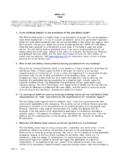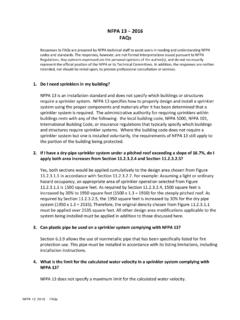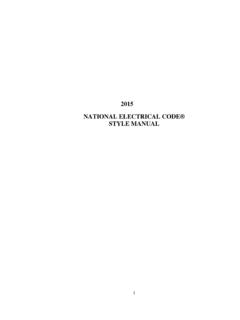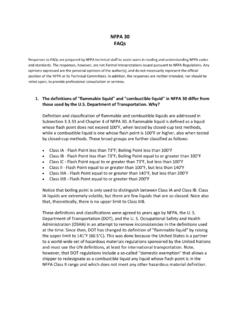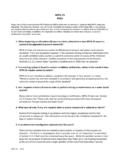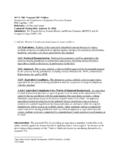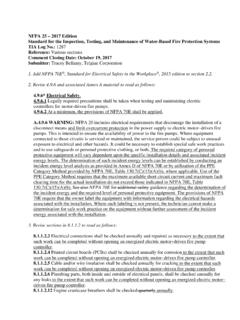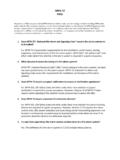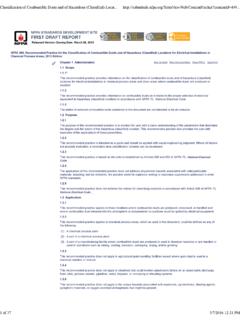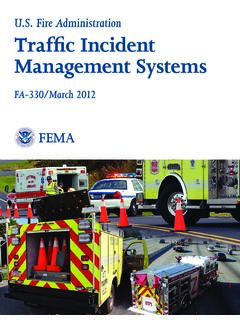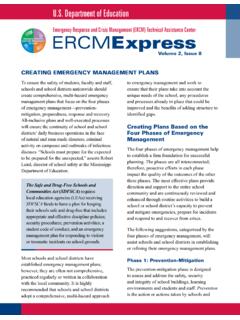Transcription of Firefighter Fatalities in the US in 2020 - NFPA
1 Firefighter Fatalities in the US in 2020 Rita F. Fahy and Jay T. PetrilloOctober 2021 Copyright 2021 National Fire Protection Association ( nfpa ) nfpa Research pg. 1 2020 Experience As could be expected, in 2020, the largest share of Firefighter deaths in the US resulted from exposure to COVID-19. nfpa has received notification of the deaths of almost 80 firefighters due to exposure to COVID-19 while on the job in 2020. Many of the cases were tied to specific emergency calls, particularly medical calls, where firefighters were exposed to infected members of the public. Other cases were attributed to exposure at the fire station. As a result, the total number of on-duty Firefighter deaths in 2020 was higher than it has been since the late 1970s (with the exception of 2001). Of the 140 on-duty deaths in 2020, 78 were due to COVID. This report will focus on the 62 non-COVID deaths. Figure 1 shows the trend over the years, excluding the 340 Firefighter deaths on 9/11 and the cancer-related deaths of firefighters who responded to the World Trade Center that have occurred since 20011.
2 The solid line for 2020 shows how the non-COVID deaths compare to deaths in previous years. Of the 62 firefighters who died in the US while on duty in 2020, 27 were volunteer firefighters, 23 were career firefighters, eight were contractors to state and federal land management agencies, two were employees of a federal land management agency, and two were members of the military2. There were two incidents with two Fatalities in 2020. Analyses in this report will examine the types of duty associated with Firefighter deaths, the cause and nature of fatal injuries to firefighters, and the ages of the firefighters who died. The report will also highlight deaths on the fireground and in motor vehicle-related Finally, the report will present summaries of individual incidents that illustrate important concerns for Firefighter safety. This annual study includes only on-duty Firefighter Fatalities that occurred in the 50 states and the District of Columbia.
3 In addition, there were two on-duty Firefighter Fatalities in 2020 in American Samoa and three American firefighters were killed on a wildland fire in Australia. Introduction Each year, nfpa collects data on all the Firefighter Fatalities in the US that resulted from injuries or illnesses that occurred while the victims were on duty. The term on duty refers to: Being at the scene of an alarm, whether it is a fire or non-fire incident (including EMS calls) Responding to or returning from an alarm Participating in other fire department duties, such as training, maintenance, public education, inspection, investigation, court testimony, or fundraising Being on call or standby for assignment at a location other than the Firefighter s home or place of business 0204060801001201401601807779818385878991 9395979901030507091113151719 Number of DeathsYearFigure 1. On-Duty Firefighter Deaths: 1977 2020* Does not include the 340 Firefighter deaths at the World Trade Center in *14062 nfpa Research pg.
4 2 On-duty Fatalities include any injury sustained in the line of duty that proves fatal, any illness incurred as a result of actions while on duty that proves fatal, and any fatal mishaps involving nonemergency occupational hazards that occur while on duty. The types of injuries included in the first category are mainly those that occurred at a fire or other emergency incident scene, in training, or in crashes while responding to or returning from alarms. Illnesses (including heart attacks) are included when the exposure or onset of symptoms occurred during a specific incident or on-duty activity. The types of firefighters included in this study are: Members of local career and volunteer fire departments Seasonal, full-time, and contract employees of state and federal agencies who have fire suppression responsibilities as part of their job description Prison inmates serving on firefighting crews Military personnel performing assigned fire suppression activities Civilian firefighters working at military installations Members of facility or industrial fire brigades Fatal injuries and illnesses are included even in cases where death was considerably delayed.
5 When the injury and death occurred in different years, the incident is counted for the year of the injury. In the case of COVID deaths, nfpa is following inclusion criteria similar to that used by the US Public Safety Officers Benefits (PSOB) Program and the International Association of Fire Fighters (IAFF) in counting active on-duty firefighters who were working at the time their illness was diagnosed. The Safeguarding America s First Responders Act allows PSOB to recognize the eligibility of COVID-19 diagnoses for firefighters within 45 days of their last day on duty. nfpa recognizes that other organizations report the number of duty-related Firefighter Fatalities using different, more expansive definitions and some include deaths that occurred when the victims were off-duty. (See, for example, the US F ire Administration and National Fallen Firefighters Foundation websites.) Readers comparing reported losses should carefully consider the definitions and inclusion criteria used in any study.
6 Long-term effects on firefighters physical and emotional health This study focuses on the deaths of firefighters that are due to specific events while on-duty, but nfpa recognizes that a comprehensive study of on-duty Firefighter Fatalities would include chronic illnesses, such as cancer or heart disease, that arise from occupational factors and prove fatal. The number of deaths due to long-term exposure, however, cannot be estimated at this time due to limitations in tracking the exposure of firefighters to toxic environments and substances and the potential long-term effects of such exposures. Besides the challenges that Firefighter illnesses pose for a complete picture of the Firefighter fatality problem, we would be remiss if we did not also monitor the increasingly well-publicized problem of Firefighter suicide. Suicide: According to the Firefighter Behavioral Health Alliance (FBHA), 97 firefighters and 26 EMTs and paramedics died by suicide in 2020.
7 (This number may change as new reports are validated by the FBHA.) Recognition of the importance of behavioral health programs and peer support for firefighters has become widespread in recent years. As with heart disease and cancer, this is a problem that follows firefighters after their careers end, whether in retirement or some other form of separation from the fire service. Many programs exist to address these problems, including Share the Load, an effort by the National Volunteer Fire Council (NVFC) that connects firefighters, EMTs, and their families with resources and support for their mental well-being. In nfpa Research pg. 3 June 2020, they launched a directory of licensed behavioral health professionals familiar with the fire service culture to help improve access to behavioral health care for firefighters. The directory can be accessed on the Share the Load web page. The International Association of Fire Fighters (IAFF) has offered advice on establishing a peer support program.
8 In October 2019, the IAFF launched a suicide reporting system for its members and has developed material on coping in the aftermath of a friend or colleague s death by suicide. In collaboration with the National Fallen Firefighters Foundation (NFFF), the Medical University of South Carolina has developed a training course for counselors who work with firefighters. Both the US House and Senate have introduced bills to establish a public safety officer suicide reporting system at the Centers for Disease Control and Prevention (CDC) to collect information on the incidence of suicide in this group and to aid in the study of ways to reduce deaths by suicide among firefighters and other first responders by improving detection, prevention, and treatment of behavioral health issues. It would also allow funding for peer support programs. The legislation was introduced in the House in 2019 and in the Senate in January 2020.
9 nfpa 1500 , Standard on Fire Department Occupational Safety, Health, and Wellness Program, requires access to a behavioral health program that provides assessment, counseling, and treatment for such issues as stress, alcohol and substance abuse, anxiety, depression, traumatic exposure, suicidality, and personal problems. The goal of such programs is to change the culture of the fire service, help people to identify warning signs, eliminate any stigma associated with mental health issues and asking for help, and provide training and assistance with retirement planning. According to FBHA statistics, almost one-fifth of the firefighters and EMTs who died by suicide were retired firefighters and EMTs. Early recognition and treatment of behavioral health issues are key to addressing this problem. Cancer: Cancer is well-recognized as a significant risk in the fire service. Attention has increasingly focused on cancer risks and cancer prevention in the fire service through research, education, behavioral changes, and a variety of controls to minimize exposure to contaminants.
10 Although we cannot identify the total number of fire service-related cancer deaths that occur each year, the IAFF alone lists on its website 117 Firefighter cancer deaths in 2020. Studies have shown a link between cancer and firefighting. The National Institute for Occupational Safety and Health (NIOSH) undertook two large studies focused on Firefighter cancer and concluded that firefighters face a 9 percent increase in cancer diagnoses and a 14 percent increase in cancer-related deaths compared to the general population in the US. The first study was a multiyear project to examine the cancer risk in firefighters using the health records of approximately 30,000 current and retired career firefighters from three large city fire departments to look at mortality and cancer incidents. The second study looked at exposure response among 20,000 firefighters from the same fire departments. Results of the first phase, which showed evidence of a relationship between firefighting and cancer, were published in October 2013.

